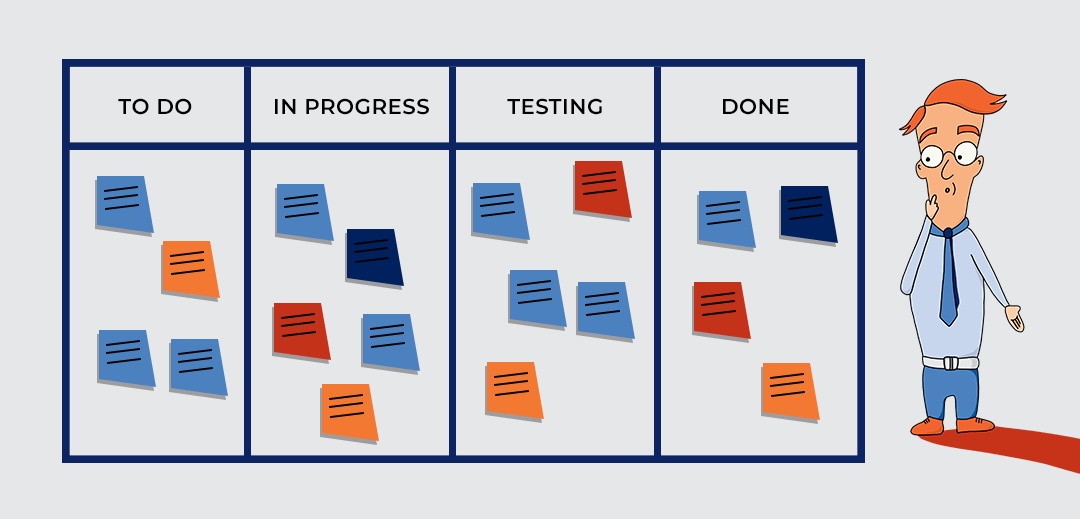In today’s rapidly evolving business landscape, adaptability and efficiency are essential for project success. Traditional project management approaches often struggle to keep pace with changing requirements and dynamic environments. This is where the Kanban methodology shines, offering a flexible and iterative framework for managing projects with greater agility and responsiveness. In this article, we’ll explore how the Kanban methodology enhances agility in project management and how professionals can benefit from incorporating it into their workflows.
Understanding Kanban Methodology
Originating from the Japanese manufacturing industry, Kanban is a visual management technique that emphasizes continuous improvement, flow, and transparency. The word “Kanban” itself translates to “visual signal” or “card” in Japanese, reflecting the methodology’s reliance on visual cues to manage work processes.
At its core, Kanban provides a visual representation of work items and their progress through various stages of a workflow. By visualizing work-in-progress (WIP), teams can identify bottlenecks, prioritize tasks, and optimize their processes for efficiency and effectiveness.
Enhancing Agility with Kanban
One of the key advantages of Kanban is its ability to enhance agility in project management. Unlike traditional project management methodologies that rely on fixed timelines and rigid plans, Kanban embraces change and uncertainty, allowing teams to adapt quickly to evolving requirements and priorities.
Here’s how Kanban enhances agility in project management:
Flexibility: Kanban’s flexible approach allows teams to adjust their workflows in response to changing priorities, customer feedback, or market conditions. Work items are pulled through the workflow based on capacity and demand, rather than being pushed according to predetermined schedules.
Continuous Improvement: Kanban encourages a culture of continuous improvement, where teams regularly reflect on their processes and seek opportunities for optimization. By visualizing workflow bottlenecks and inefficiencies, teams can identify areas for improvement and implement changes incrementally.
Transparency: Kanban provides transparency into the status of work items, enabling stakeholders to track progress and make informed decisions. Visual Kanban boards display the status of each task in real-time, allowing project managers to identify potential risks or delays and take proactive measures to mitigate them.
Reduced Waste: Kanban minimizes waste by limiting work-in-progress (WIP) and focusing on completing tasks before starting new ones. By optimizing flow and reducing multitasking, teams can improve productivity and deliver value more efficiently.
Empowered Teams: Kanban empowers project teams to self-organize and collaborate effectively. With clear visibility into the status of work items, team members can take ownership of tasks and coordinate their efforts to achieve project goals.
Benefits of Online MBA Project Management Programs
Professionals looking to enhance their project management skills and incorporate methodologies like Kanban into their practice can benefit from pursuing an online MBA project management program. These programs offer a comprehensive curriculum that covers essential project management concepts, tools, and techniques, providing students with the knowledge and skills needed to succeed in today’s competitive business environment.
Key benefits of online MBA project management programs include:
Flexibility: Online MBA programs offer flexibility and convenience, allowing students to balance their studies with work and other commitments. With 24/7 access to course materials and resources, students can study at their own pace and from anywhere in the world.
Specialized Curriculum: MBA project management programs offer a specialized curriculum that focuses on project management principles, methodologies, and best practices. Courses cover topics such as project planning, risk management, stakeholder communication, and project team structure, providing students with a comprehensive understanding of project management concepts and techniques.
Practical Experience: Many online MBA programs incorporate real-world case studies, projects, and simulations to provide students with hands-on experience in project management. These practical learning opportunities allow students to apply theoretical knowledge to real-world scenarios and develop critical thinking and problem-solving skills.
Networking Opportunities: Online MBA programs provide networking opportunities with fellow students, alumni, and industry professionals. Discussion forums, group projects, and virtual networking events enable students to connect with others in the field, share insights, and build professional relationships that can benefit their careers.
Understanding Project Team Structure
In project management, the structure of the project team plays a crucial role in determining the success of a project. The project team structure defines the roles, responsibilities, and relationships of team members, ensuring clarity and accountability throughout the project lifecycle.
Common project team structures include:
-
Functional Teams: In a functional team structure, team members are organized based on their functional expertise, such as marketing, engineering, or finance. This structure promotes specialization and efficiency but can lead to silos and communication barriers between departments.
-
Matrix Teams: Matrix teams combine elements of functional and projectized structures, allowing team members to report to both functional managers and project managers. This structure provides flexibility and resource allocation but can result in conflicts over priorities and authority.
-
Projectized Teams: In a projectized team structure, team members are dedicated solely to a specific project for its duration. This structure promotes project focus and accountability but can lead to resource constraints and competition for skilled personnel.
-
Cross-Functional Teams: Cross-functional teams bring together individuals from different departments or disciplines to work on a common project. This structure encourages collaboration, creativity, and diversity of perspectives but requires effective communication and teamwork to succeed.
Conclusion
The Kanban methodology offers a powerful framework for enhancing agility in project management, enabling teams to adapt quickly to changing requirements and priorities. By visualizing work processes, minimizing waste, and empowering teams to self-organize, Kanban promotes continuous improvement and efficiency throughout the project lifecycle.
Professionals looking to enhance their project management skills and incorporate methodologies like Kanban into their practice can benefit from pursuing an online MBA project management program. These programs offer a specialized curriculum, practical experience, and networking opportunities that can help students succeed in today’s competitive business environment. Additionally, understanding the project team structure is essential for effective project management, as it defines the roles, responsibilities, and relationships of team members, ensuring clarity and accountability.
FAQs
What is Kanban methodology, and how does it differ from other project management approaches?
Kanban methodology is a visual management technique that emphasizes continuous improvement, flow, and transparency in project management. Unlike traditional project management approaches that rely on fixed timelines and rigid plans, Kanban embraces change and uncertainty, allowing teams to adapt quickly to evolving requirements and priorities.
How can Kanban enhance agility in project management?
Kanban enhances agility in project management by providing flexibility, promoting continuous improvement, ensuring transparency, reducing waste, and empowering teams to self-organize and collaborate effectively. By visualizing work processes and minimizing bottlenecks, Kanban enables teams to respond quickly to changes and deliver value more efficiently.
What are the benefits of pursuing an online MBA project management program?
Pursuing an online MBA project management program offers several benefits, including flexibility, specialized curriculum, practical experience, and networking opportunities. These programs provide students with the knowledge and skills needed to succeed in today’s competitive business environment and enhance their project management expertise.
What is project team structure, and why is it important in project management?
Project team structure defines the roles, responsibilities, and relationships of team members in a project. It ensures clarity, accountability, and effective communication throughout the project lifecycle. Understanding project team structure is essential for organizing resources, allocating tasks, and promoting collaboration within the project team.
How can I incorporate Kanban methodology into my project management practice?
To incorporate Kanban methodology into your project management practice, start by visualizing your workflow and creating a Kanban board to track work items and their progress. Limit work-in-progress (WIP) to improve flow and focus on completing tasks before starting new ones. Encourage continuous improvement by regularly reviewing and refining your processes based on feedback and data. Additionally, empower your team members to self-organize and collaborate effectively to achieve project goals.





